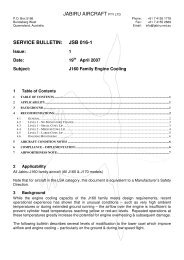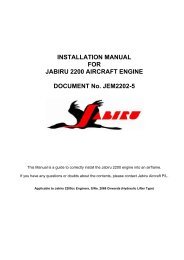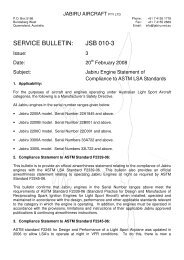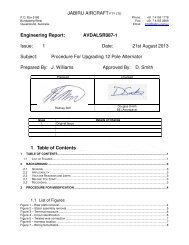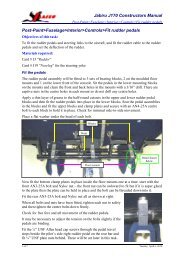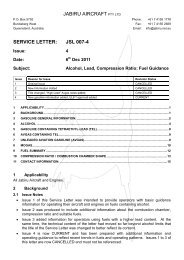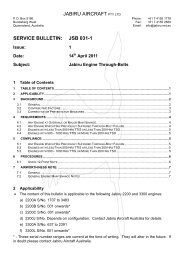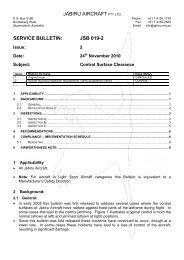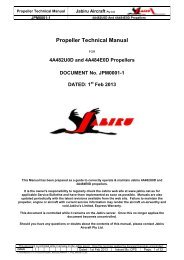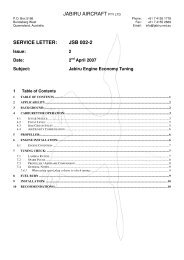INSTRUCTION AND MAINTENANCE MANUAL FOR JABIRU 2200 ...
INSTRUCTION AND MAINTENANCE MANUAL FOR JABIRU 2200 ...
INSTRUCTION AND MAINTENANCE MANUAL FOR JABIRU 2200 ...
You also want an ePaper? Increase the reach of your titles
YUMPU automatically turns print PDFs into web optimized ePapers that Google loves.
Jabiru Aircraft Pty LtdInstruction & Maintenance ManualJabiru <strong>2200</strong> Aircraft EngineHydraulic Valve Lifter Models2.3 General DescriptionIt is said that "aircraft are designed around available engines".Jabiru believe that the Jabiru range of very light engines offers opportunities for lightaircraft designers to develop a new generation of light aircraft.Jabiru engines are designed to be manufactured in small batch quantities using the verylatest Computer Numerically Controlled (CNC) machine tools. All Jabiru engines aremanufactured and assembled in a very modern factory in Bundaberg where each engineis run in on a Dynometer and calibrated before delivery. The crankcase halves, cylinderheads, crankshaft, starter motor housings, gearbox cover (the gearbox powers thedistributor rotors) and coil mounts – together with many smaller components are machinedfrom solid. The sump (oil pan) is the only casting. The cylinders are machined from bar4140 chrome molybdenum alloy steel, with the pistons running directly in the steel bores.The crankshaft is also machined from 4140 chrome molybdenum alloy steel, the journalsof which are precision ground prior to being Magnaflux inspected. The camshaft ismanufactured from 4140 chrome molybdenum alloy steel – with nitrided journals & cams.The propeller is direct crankshaft driven and does not use a reduction gearbox. Thisfacilitates its light-weight design and keeps maintenance costs to a minimum. Thecrankshaft features a removable propeller flange which enables the easy replacement ofthe front crankshaft seal and provides for a propeller shaft extension to be fitted, shouldthis be required for particular applications. Cylinder heads are machined from solidaluminium billet, thereby providing a substantive quality trail to material source.Connecting rods are machined from 4140 alloy steel and the 45mm big end bearings areof the automotive slipper type.Many components of the engines are sourced from outside Suppliers. These items includecamshaft followers, and the bendix gear in the starter motor. The ignition coils are alsosourced from outside Suppliers, and are modified by Jabiru for their own particularapplication.An integral alternator using rare earth magnets provides alternating current for batterycharging and electrical accessories. The alternator is attached to the flywheel and isdriven directly by the crankshaft. The ignition system is a transistorised electronic system;two fixed coils mounted adjacent to the flywheel are energised by rare earth magnetsattached to the flywheel. The passing of the coils by the magnets creates the high voltagecurrent which is then transported by high tension leads to the centre post of twoautomotive type distributors (which are simply rotors and caps) before distribution toautomotive spark plugs, two in the top of each cylinder head. The ignition system is fixedtiming and, therefore, removes the need for timing adjustment. The ignition system is fullyredundant, self-generating and does not depend on battery power.The crankshaft is designed with a double bearing at the propeller flange end and a mainbearing between each big end; it therefore does not have flying webs. 48mm mainbearings are also of the automotive slipper type. Thrust bearings are located fore and aftof the front double bearing allowing either tractor or pusher installation.This document is controlled while it remains on the Jabiru server. Once this no longer applies the document becomes uncontrolled.REVISION 0 1 2 3 4 5 6 7 8 9 Dated : June 2010 Issued By: DPS Page: 8 of 116L:\files\Manuals_For_Products\Engine_Manuals\Transition\JEM2204-9_I&M_unsigned.docx





